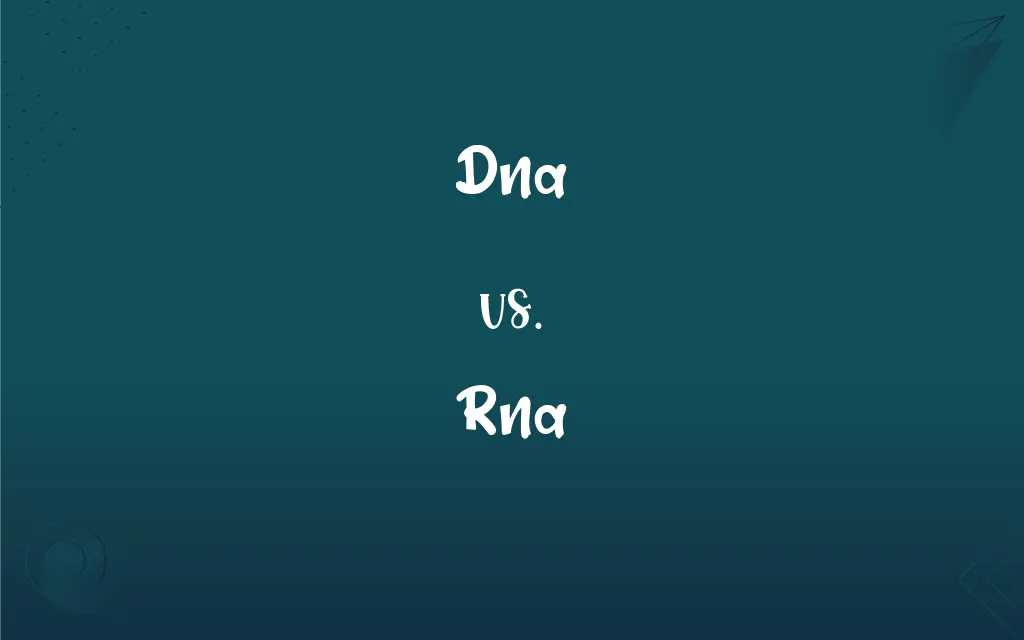DNA vs. RNA: What's the Difference?
Edited by Aimie Carlson || By Harlon Moss || Updated on October 9, 2023
DNA stores genetic information; RNA translates it for protein synthesis. DNA is double-stranded; RNA is single-stranded.

Key Differences
DNA (Deoxyribonucleic Acid) and RNA (Ribonucleic Acid) are two distinct molecules, yet they are intrinsically linked in cellular biology. DNA serves as the long-term storage unit for genetic information. Residing primarily in the cell nucleus, it carries instructions for all cellular functions and is passed from one generation to the next. This continuity ensures that organisms retain their unique characteristics across generations.
RNA, in contrast, operates more as a messenger. While DNA holds the instructions, RNA reads and interprets them. RNA transcribes the information from DNA and then facilitates the synthesis of proteins, which are essential for various cellular activities. Various types of RNA exist, including messenger RNA (mRNA), transfer RNA (tRNA), and ribosomal RNA (rRNA), each with unique functions in protein synthesis.
Structurally, DNA and RNA present clear differences. DNA is a double-stranded helix, while RNA is typically single-stranded. Furthermore, while both are made of nucleotides, DNA uses the bases adenine (A), cytosine (C), guanine (G), and thymine (T). RNA, however, replaces thymine with uracil (U).
In essence, DNA and RNA are central to life's molecular foundation. While DNA stores the blueprint for life, RNA ensures these plans manifest in the form of proteins, facilitating various biological processes and developments.
Comparison Chart
Function
Stores genetic information
Translates genetic info for protein synthesis
ADVERTISEMENT
Structure
Double-stranded
Single-stranded
Bases
A, C, G, T
A, C, G, U
Sugar
Deoxyribose
Ribose
Location in Cell
Primarily in the nucleus
Throughout the cell
DNA and RNA Definitions
Dna
The molecule containing an organism's genetic code.
DNA sequencing can reveal an individual's ancestry.
ADVERTISEMENT
Rna
Transcribes and translates DNA's instructions.
RNA transcribes genes from DNA to make proteins.
Dna
Double-stranded helical structure.
DNA's double helix is iconic in biology.
Rna
Single-stranded molecule translating genetic data.
RNA plays a key role in protein synthesis.
Dna
Replicates to pass genetic information.
Cells duplicate their DNA before dividing.
Rna
Contains uracil instead of thymine.
In RNA, adenine pairs with uracil.
Dna
Comprises genes governing traits and characteristics.
Eye color is determined by specific segments of DNA.
Rna
Crucial for cellular activities and processes.
Without RNA, DNA's instructions would remain unused.
Dna
Subject to mutations altering genetic code.
Certain DNA mutations can predispose individuals to diseases.
Rna
Various types facilitate protein synthesis.
MRNA is a type of RNA carrying genetic information.
Rna
A nucleic acid present in all living cells and many viruses, consisting of a long, usually single-stranded chain of alternating phosphate and ribose units, with one of the bases adenine, guanine, cytosine, or uracil bonded to each ribose molecule. RNA molecules are involved in protein synthesis and sometimes in the transmission of genetic information. Also called ribonucleic acid.
Rna
(biochemistry) a long linear polymer of nucleotides found in the nucleus but mainly in the cytoplasm of a cell where it is associated with microsomes; it transmits genetic information from DNA to the cytoplasm and controls certain chemical processes in the cell;
Ribonucleic acid is the genetic material of some viruses
FAQs
What does DNA stand for?
DNA stands for Deoxyribonucleic Acid.
Is DNA single or double-stranded?
DNA is double-stranded.
What is RNA's primary function?
RNA's primary function is to translate genetic information for protein synthesis.
What role does RNA play in protein synthesis?
RNA transcribes and translates DNA's instructions to synthesize proteins.
Are there different types of RNA?
Yes, there are various types of RNA, including mRNA, tRNA, and rRNA.
How does RNA differ from DNA in its bases?
RNA contains uracil (U) instead of thymine (T).
Where is DNA primarily found in a cell?
DNA is primarily found in the cell nucleus.
Which sugar is present in DNA's backbone?
Deoxyribose is the sugar in DNA's backbone.
Which sugar does RNA have?
RNA contains ribose sugar.
What's the shape of DNA called?
The shape of DNA is called a double helix.
Why is RNA's role considered "transient"?
RNA is seen as transient because it's synthesized, used, and then degraded, unlike DNA's permanence.
What happens if RNA malfunctions?
RNA malfunction can lead to incorrect protein synthesis and potential diseases.
How is RNA produced in the cell?
RNA is produced by transcribing DNA.
What do genetic tests analyze in an individual?
Genetic tests analyze sequences in DNA to detect any abnormalities or mutations.
Can RNA exist outside of a cell?
RNA can exist outside cells, as seen with some viruses having RNA genomes.
Why is RNA necessary for cells?
RNA is necessary to interpret and enact the instructions held in DNA.
Do all organisms have RNA?
Yes, all living organisms have RNA to translate DNA's genetic information.
Are DNA sequences unique to every individual?
Yes, except for identical twins, everyone's DNA is unique.
What role do genes play in DNA?
Genes, segments of DNA, hold instructions for producing proteins and other molecules.
Can DNA be seen with the naked eye?
No, DNA is microscopic and can't be seen without specialized tools.
About Author
Written by
Harlon MossHarlon is a seasoned quality moderator and accomplished content writer for Difference Wiki. An alumnus of the prestigious University of California, he earned his degree in Computer Science. Leveraging his academic background, Harlon brings a meticulous and informed perspective to his work, ensuring content accuracy and excellence.
Edited by
Aimie CarlsonAimie Carlson, holding a master's degree in English literature, is a fervent English language enthusiast. She lends her writing talents to Difference Wiki, a prominent website that specializes in comparisons, offering readers insightful analyses that both captivate and inform.































































